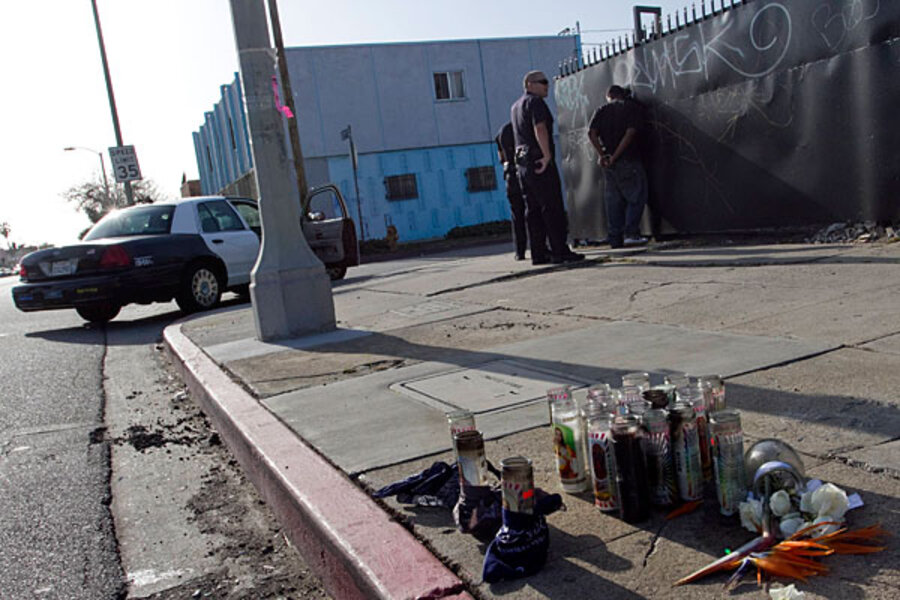Los Angeles riots: 20 years later, has LAPD reformed?
Loading...
| Los Angeles
Twenty years after a video of officers kicking and clubbing motorist Rodney King made the Los Angeles Police Department the poster child for police abuse, residents and community activists say the department has turned a corner.
A succession of police chiefs – most notably William Bratton – have made reform a top priority. Eight years of federal oversight helped clean up the department. And the changing demographics of the LAPD – 37 percent white, compared with 59 percent in 1992 – has changed the character of the force, many say.
There are signs of slippage, some say, such as a reluctance to reprimand officers who were found by a commission to have killed or wounded people unjustifiably. But on a 20th anniversary bus tour of the riot areas Tuesday – organized by Operation Hope, which was formed in the wake of the riots to expand economic opportunity in underserved communities – the notes were universally positive.
“Don’t you love the police when they’re on your side?” said Eric Clay, HOPE’s vice president for community lending, going for a laugh as tour guide on one bus, nodding out the window at the police escort.
The Los Angeles Times reports that 70 percent of Los Angeles residents now say they approve of the police department, and at one stop on the bus tour, the Korean owner of a small convenience store offers words of praise.
“Twenty years ago, when the police showed up, everyone got more tense. Now you feel they’re here to help," he says. "That’s a big change.”
Across the street, Mayor Antonio Villaraigosa speaks to an assembly of elementary school students gathered at the Quincy Jones Elementary School, built in the heart of South Los Angeles in the wake of the riots. Noting the hiring of more women and Latino officers, he says, “because of the attention and outcry of this city, we’ve been able to make hosts of reforms.”
Earl Ofari Hutchinson, president of the Los Angeles Urban Policy Roundtable and a longtime critic of the LAPD, says the department has made big strides. Several blue-ribbon commissions have helped, as has community policing, in which cops on the beat spend time getting to know residents rather than just speeding through neighborhoods in their squad cars. Federal oversight from 2001 to 2009 also meant comprehensive audits.
But it was the leadership of Mr. Bratton, who arrived in 2002 and left in 2009, that marked a high point for the department in becoming kinder and gentler and demanding zero tolerance for abuse, violence, and misconduct.
“Bratton really went out of his way to say what was needed, [and] also to show up at our meetings and talk to us all the time,” says Mr. Hutchinson. “There was a mandate from within to hire more women, Latinos, Asians, and gays, and a personal demonstration from him and other leadership that he meant everything he said. I’d have to say it has worked.”
Local black activist Najee Ali likewise gives the LAPD an “A” for what it has achieved. He says police regularly come into the neighborhoods for formal discussions with residents and have improved response times dramatically, which makes residents feel the police are for them rather than against them.
“They have a senior lead officer assigned directly to work with each neighborhood so that when some complaint or nuisance report comes in, it’s usually dealt with within 24 hours,” he says. Those reports include complaints such as vagrancy, gang activity, drug dealers, and graffitti.
The board of directors of the Los Angeles Police Protective League, however, suggests that these reforms are not the product of the riots.
“Many of these retrospectives have included analyses that overstate the riots’ role in the evolution of the Department,” the league says in a release. “Any balanced analysis must recognize that policing in general has evolved across the nation. Changes in the Department were part of a larger national trend of evolving approaches to policing.”
The league says that even though officers of Hispanic descent now account for 42 percent of the police force, “this change is as much a result of the changing community demographics as it is of any single event in the city’s history.”
It also points out that many LAPD officers working today were not on the job two decades ago: of the 9,940 officers on the force, only 2,641 were on the job in April 1992.
But with the exit of Bratton, Hutchinson and others say they are concerned that old habits could be returning. The killing of an unarmed black man in 2011, a 90-bullet shootout with a suspect after a car chase in April, and revelations that an officer racially profiled Latinos are among the concerns.
Hutchinson notes that current Chief Charlie Beck has come under fire from the current police commission for his reluctance to reprimand officers the commission found used excessive force.
“There are still some of the old troubling signs,” says Hutchinson. “Officers that overuse deadly force or commit acts of misconduct must be punished. Without it, it reinforces the notion that officers can administer street corner justice. This is the practice that got the LAPD into so much hot water in years past.”





